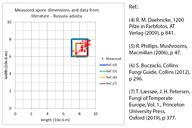|
|
click photo for larger file

Russula adusta
Winecork Brittlegill
|
Photographer: Dr. Amadej Trnkoczy
ID: 0000 0000 0923 0084 (2023-09-07)Copyright © 2023 Dr. Amadej Trnkoczy
|
|
INFORMATION PROVIDED WITH THE PHOTO
|
date of photo Aug 21, 2023
latitude 46.35951 longitude 13.70422
View on Google Maps.
location
Lower Trenta valley, right bank of river Soča; between villages Soča and Trenta; next to the trail between Skokar abandoned farmhouse, Trenta 2. and Trenta 2a cottage, East Julian Alps (Posočje, Slovenia)family
Russulaceae
notes Slo.: osmojena golobica - syn.: Agaricus adustus Pers., Omphalia adusta (Pers.) Gray, Russula eccentrica Peck, Russula subusta Burl, Russula nigricans Fr. - Habitat: mixed Fagus sylvatica forest with scattered Picea abies, a closest large Picea abies at about 5 m distance, a small one about 3 m; moderately inclined mountain slope, SE aspect; dry place; calcareous, colluvial, skeletal ground with scattered rocks; in shade; partly protected from direct rain by tree canopies, average precipitations ~ 3.000 mm/year, average temperature 7-9 deg C, elevation 560 m (1.840 feet), alpine phytogeographical region. - Substratum: soil, humus, rotten fallen leaves. - Comments (pertain to Flickr album Russula adusta): This Holarctic species known from almost all European countries is a member of charred russulas (subgenus Compactae). Similar species include Russula albonigra, Russula nigricans. Russula anthracina and R. densifolia. All of them are medium sized or large but often hidden under fallen leaves or other ground debris. They are not colorful. When young they are muddy whitish or grayish but they soon become dark muddy brown, dark gray of black. They all bruise to black or dark gray. A dry Russula adusta looks like a put out site of fire (see Fig. 14.) When old and covered by all kind of ground debris and usually growing in deep shade they are not at all attractive. It is not always easy to determine them to species level particularly if they are old. - Charred russulas have generally white spore print. Only two of them have beige spore print – Russula adusta and Russula anthracina (Ref. 2). The spores of both species are very similar and hence not a useful trait to distinguish them. The reason that we decided for the former was the smell, which was strong, musty, unpleasant (some say on old wine barrels). During drying a small piece of the specimen its unpleasant smell was noticeable in the whole room. - Russula adusta forms mycorrhiza mainly with conifers. However, in montane regions it can be found also in beech forests with scattered Picea abies or Pine species (Ref.:3). It grows only - xceptionally in pure broadleaved forests. - Three (quite old) pilei found; pilei diameter 7-9 cm, taste of flesh mild, mushroomy, on earth; taste of gills distinctive on some kind of chemistry; smell strong, unpleasant, musty, on dirt socks; during drying of a specimen awful; SP pale beige, oac7; pilei cuticle peeling modest; bruising black but not rapidly; when dry completely black apart of dark gray gills. - Spores with low incomplete mesh and some warts. Dimensions: (7,2) 8 - 9,1 (9,3) × (6,4) 6,7 - 7,8 µm; Q = (1,1) 1,14 - 1,28 (1,3); N = 32; Me = 8,6 × 7,1 µm; Qe = 1,2. Olympus CH20, NEA 100x/1.25, magnification 1.000 x, oil; in water, fresh material. AmScope 500 digital camera. - Ref.: (1) Personal communication with Mr. Bojan Ror, gobenabovskem.si (2) J. Breitenbach, F. Kraenzlin, Eds., Fungi of Switzerland, Vol. 6. Verlag Mykologia (2005), p 126. (3) G.J. Krieglsteiner (Hrsg.), Die Grosspilze Baden-Württembergs, Band 2., Ulmer (2000), p 433. (4) R. M. Daehncke, 1200 Pilze in Farbfotos, AT Verlag (2009), p 841. (5) R. Phillips, Mushrooms, Macmillan (2006), p 47. (6) S. Buczacki, Collins Fungi Guide, Collins (2012), p 296. (7) T. Læssøe, J. H. Petersen, Fungi of Temperate Europe, Vol. 1., Princeton University Press, Princeton and Oxford (2019), p 377.camera Sony ILCE6000 / Carl Zeiss Vario-Tessar E 16-70 mm/f4
contributor's ID # Bot_1541/2023_DSC 3837 photo category: Fungi - fungi
|
MORE INFORMATION ABOUT THIS FUNGUS
|
| common names
Winecork Brittlegill, Blackening Russula (photographer)
View all photos in CalPhotos of Russula adusta Check Google Images for Russula adusta |
|
The photographer's identification Russula adusta has not been reviewed. Click here to review or comment on the identification. |
|
Using this photo The thumbnail photo (128x192 pixels) on this page may be freely used for personal or academic purposes without prior permission under the Fair Use provisions of US copyright law as long as the photo is clearly credited with © 2023 Dr. Amadej Trnkoczy.
For other uses, or if you have questions, contact Dr. Amadej Trnkoczy amadej.trnkoczy[AT]siol.net. (Replace the [AT] with the @ symbol before sending an email.) |
|
|
